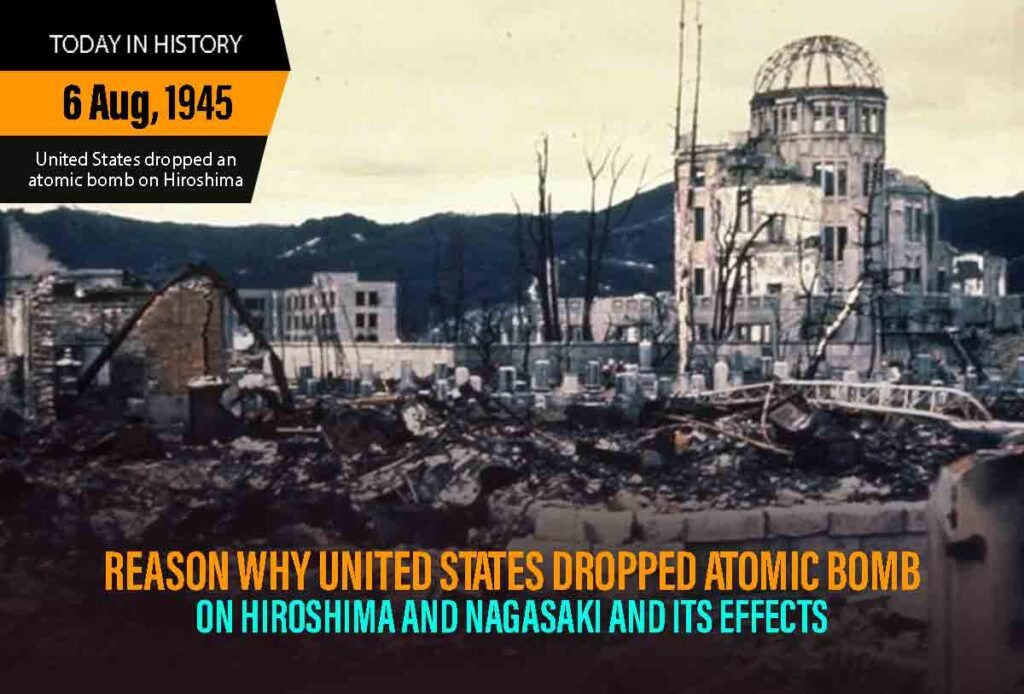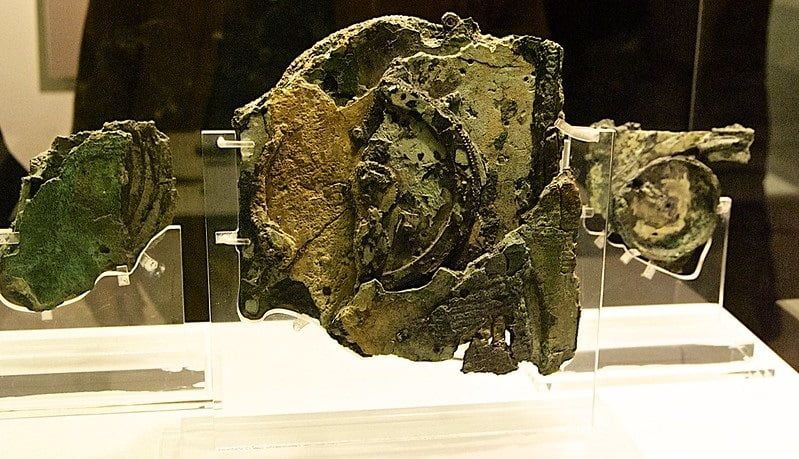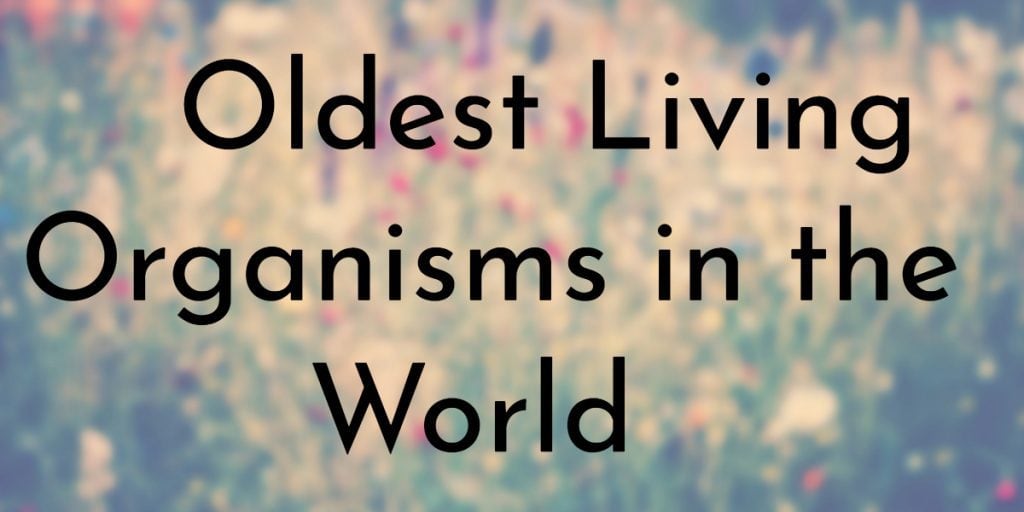On the 6th and 9th of August of 1945, the most destructive incident took place when the United States dropped the atomic bomb on Hiroshima and Nagasaki, Japan. The effects of Hiroshima and Nagasaki bombings were felt not only by the residents of the two regions but by the environment, animals and buildings alike. Why Hiroshima and Nagasaki were bombed, in the first place? What were Hiroshima and Nagasaki bomb name and weight? How did these atomic bombs on Hiroshima and Nagasaki alter the entire course of the island country’s future? Let us dig deep.
The Case Of Atomic Bomb On Hiroshima And Nagasaki
What was the reason behind the destruction of this scale? Why Hiroshima and Nagasaki were bombed on the 6th and 9th of August 1945? Why did events escalate to such a penultimate point that a grave, atomic implosion was the last resort? The US detonated these Japanese cities that maimed hundreds of thousands of people with their effects still being felt today. Here is all you need to know.
Why Hiroshima and Nagasaki were bombed by the US?
The intention behind the reason the United States dropped the atomic bomb on Hiroshima and Nagasaki, was to render the country incapable of waging war.

Hiroshima, with a population of around 3,18,000, the main target of the war was also the seventh-largest city in Japan at the time. The city also housed the Second Army and the Chugoku Regional Military headquarters.
As a result, the place had became one of the most significant military command centres in the nation. Hiroshima served as the main military shipping point for troops and equipment as well as one of the largest military supply depots. The reason why Hiroshima and Nagasaki were bombed, was to render Japan defenceless. Days after the first attack on Hiroshima, the USA also dropped a bomb on Nagasaki which devastated many.
Previously, on 7 December in the year 1941, the attack on Pearl Harbor, Hawaii (a state of the USA) took place. According to Japan, this action was a preventive and cautionary method to stop the US interference in Japanese military activity in Southeast Asia. Many called this moment a turning point for the USA, which entered World War 2 and engaged in brutal hostilities. That is why the United States dropped atomic bombs on Hiroshima and Nagasaki a few years later.
How Many Died In The Hiroshima And Nagasaki Bombings?
The bombs on Hiroshima and Nagasaki destroyed and devastated many. The blasts killed more than 170,000 people and destroyed most of the cities. Initial estimations claimed that as many as 2,00,000 of Hiroshima’s 3,40,000 citizens perished and met their untimely demise or were gravely injured.
The total casualties that occurred in Hiroshima amounted to 1,35,000. Meanwhile, in Nagasaki, it was around 64,000. The death toll in Hiroshima was 66,000 people, and in Nagasaki, it was 39,000. The effects of Hiroshima and Nagasaki bombings devastated the international sphere and not just the island country.
Also Read- Who Started WWI And Why: A Brief World War 1 Summary
What Were The Hiroshima And Nagasaki Bomb Name And Weight?
The bomb dropped on Hiroshima by the US was called Little Boy. The weight of the bomb was 4399.846 kilograms. It dropped on 6th August 1945.
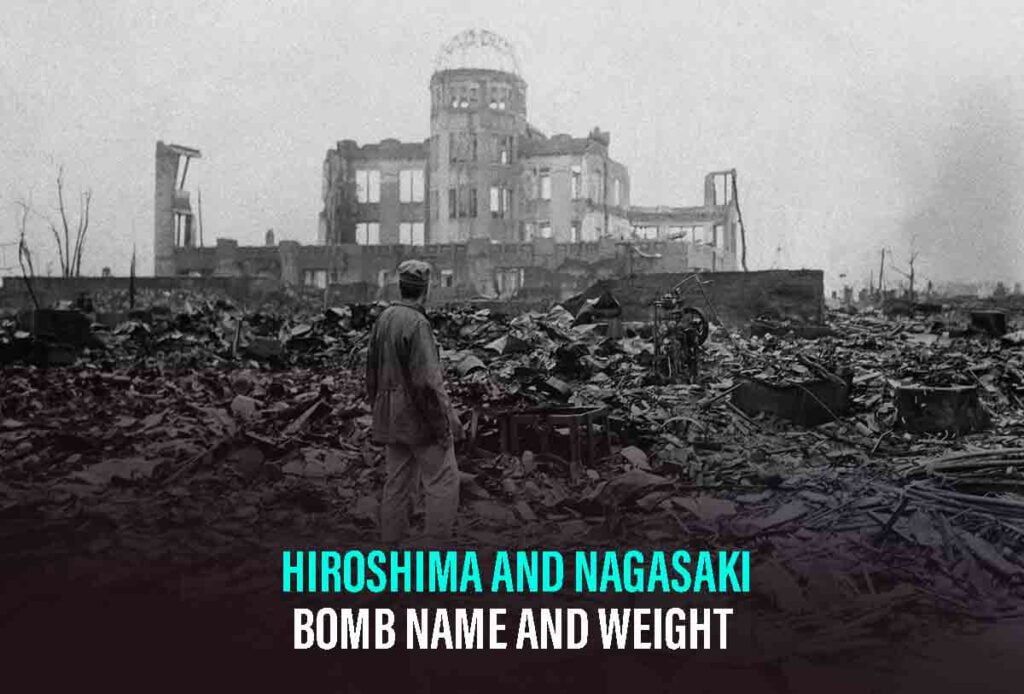
The atomic bomb dropped on Nagasaki was named Fat Man. It was actually a plutonium implosion bomb. The weight of this bomb was 4898.798 kilograms. It dropped on 9th August 1945, a few days after the first attack on Hiroshima. The Hiroshima and Nagasaki bomb name and weight created deadly atomic bombs that destroyed innocent lives.
Effects Of Hiroshima and Nagasaki Bombings
The effects of Hiroshima and Nagasaki bombings were devastating, judged by the aftermath that took place after the bombs on Hiroshima and Nagasaki were dropped.
According to a 1945 article by The Guardian, Tokyo Radio reported that the bomb’s impact was so great that almost every living thing i.e humans and animals alike, were physically burned away to death, by the blast’s extreme heat and pressure. It is simply as if they dissipated into thin air.
However, the harm and the after-effects did not stop there. As time passed, pain, remorse, destruction and desolation were brought in the future, by the radioactivity that the explosion had produced.
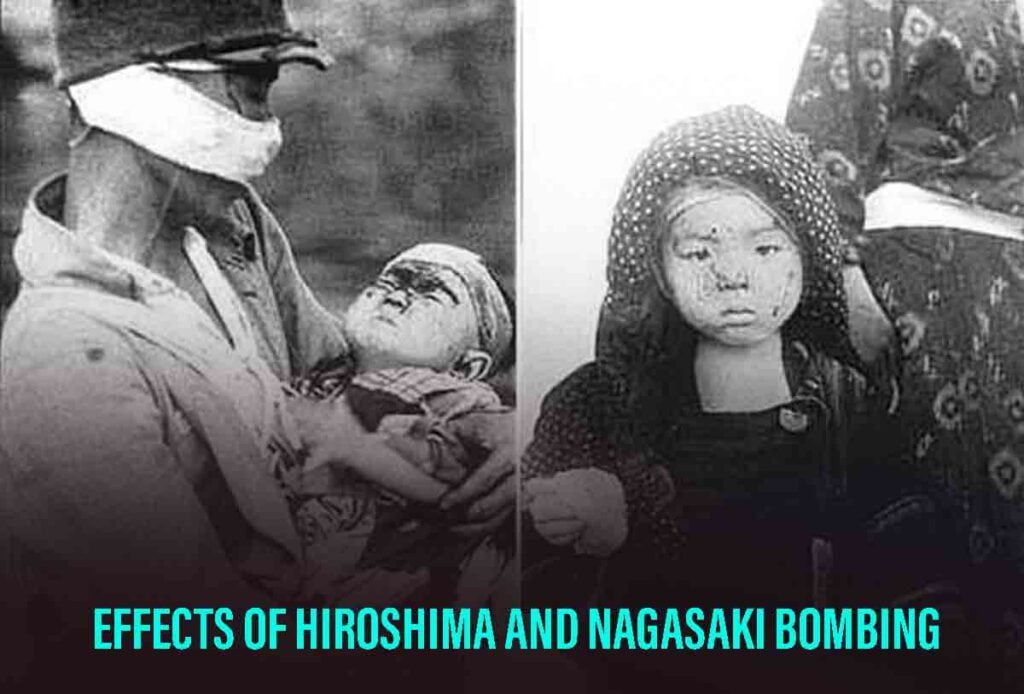
Hiroshima and Nagasaki Bombing Effects on Humans
The aftermath of the bombings on Hiroshima and Nagasaki that took place on 6th and 9th August 1945, created grave destruction. Emotionally, physically and environmentally the effects were greatly tragic.
Leukaemia was the deadliest of the long-term effects endured and faced by the atomic bomb survivors. About two years after the attacks, leukaemia rates started to rise and it faced an upward spike. The rates saw their peak, four to six years later.
The ones who were most badly impacted were kids. Children suffered a devastating fate at a tender age. According to the Radiation Effects Research Foundation, due to radiation, the attributable risk of leukaemia for bomb victims was 46%.
Also Read- Why Hitler Didn’t Attack Switzerland During WW2?
Effects Of Hiroshima And Nagasaki Bombings On Environment
After a nuclear explosion, radioactive particles are taken into the sky and eventually fall back to the ground as dust or precipitation. As a result, the sky began to ‘black rain’ with radioactive soot and dust, which had begun to descend to the ground as dangerous radioactive water. In addition to harming the environment and infrastructure, the ‘black rain’ contaminated food and water and caused radiation sickness through inhalation.
After the atomic bombs on Hiroshima and Nagasaki were dropped, the areas it affected were destroyed. Everything was burned to smithereens by the thermal radiation’s intense and excruciating heat. This radiation affected the people, trees, animals, buildings and constructions even. Many of the survivors later developed cancer, as a result of the radiation.
Hence, the effects of the bombs on Hiroshima and Nagasaki and the environment were majorly detrimental and led to radiation-related diseases.
Hiroshima and Nagasaki Now
At present, the effect of radiation has decreased exponentially and matches the levels of the natural radiation emitted by the earth. Human health will never be affected in the same way or on the same scale as it was during the Hiroshima and Nagasaki bombings.

It is, hence, safe to reside in Hiroshima and Nagasaki, as many people freely walk through the places which were back then, greatly affected and destroyed. All of the destruction has been restored, but the emotional aftershock of the bombs on Hiroshima and Nagasaki can still be felt by many.
Also Read- Death Of Adolf Hitler & Fall Of Nazi – Why Did Hitler Kill Himself
Conclusion
The incident was life-changing for many. The effects of Hiroshima and Nagasaki bombings have always been felt, even after years. The topic ‘Why the United States dropped the atomic bomb on Hiroshima and Nagasaki’ has been greatly discussed in world forums and among citizens of both countries involved.
However, decades after the tragedy of the Hiroshima and Nagasaki bombings, a question still remains — Is war genuinely the last resort? Is the torture and death of ordinary civilians justified at the cost of waging a war? These answers have a definitive answer and people need to remind themselves of what our past mistakes mean for our future.
FAQs
1. When Were Hiroshima And Nagasaki Bombed?
On 6th and 9th August 1945, the United States dropped atomic bombs on Hiroshima and Nagasaki. The bombs marked a deadly turn in the events of world history.
2. Do Hiroshima and Nagasaki still have radiation?
As of right now, the radiation levels in Hiroshima and Nagasaki are identical to the typical levels of natural radiation found throughout our entire planet. Human health can no longer be affected by it.
3. Did the US warn Japan of an atomic bomb?
Apparently, leaflets and pamphlets were disseminated, which had warnings about the atomic bomb being dropped on cities in Japan. The USA warned the Japanese and said they should take the warning with caution and proceed at their discretion. These leaflets were known as “LeMay Leaflets”.
On 26 July 1945, the US also sent a warning to Japan, in the form of the Potsdam Statement, stating that the island nation would be subject to total devastation if it did not accept the provisions of the declaration and surrender in the war right away.
4. Why was Nagasaki worse hit than Hiroshima?
The city of Nagasaki had a hilly, unevenly spread-out topography. When the blast wave hit the hills surrounding Nagasaki, it was deflected upward and away from the city. Due to this, the blast’s energy was mostly dispersed away from densely populated areas. Reconsidering the death toll, after the atomic bomb on Hiroshima and Nagasaki, the effect was worse in Hiroshima than in Nagasaki. The damage in Hiroshima was more central than in Nagasaki. Hence, if you assumed that Hiroshima was worse off than Nagasaki, then it may be factually incorrect.
However, one must sensitively approach this topic and remember that the death toll or the scale is insignificant when you take into consideration the loss of lives. No matter what the factual statistics say or what Hiroshima and Nagasaki bomb name and weight are, the emotional desolation, environmental damage and the loss of lives experienced in both areas would matter more.
For more related content, visit Discover










